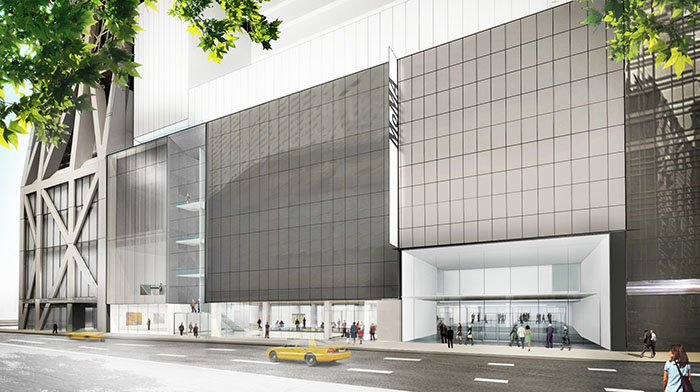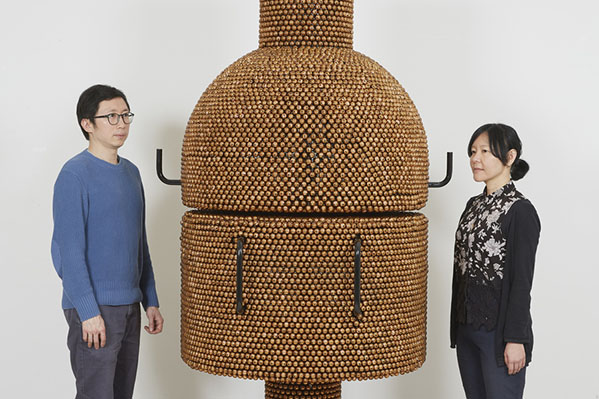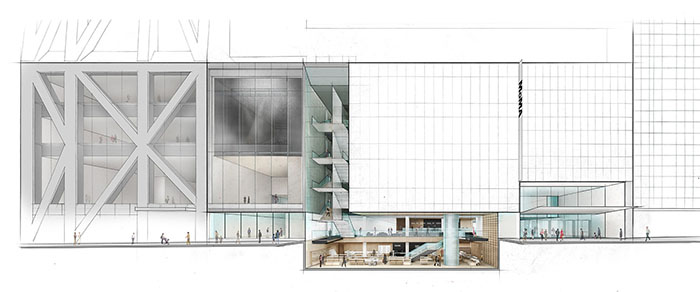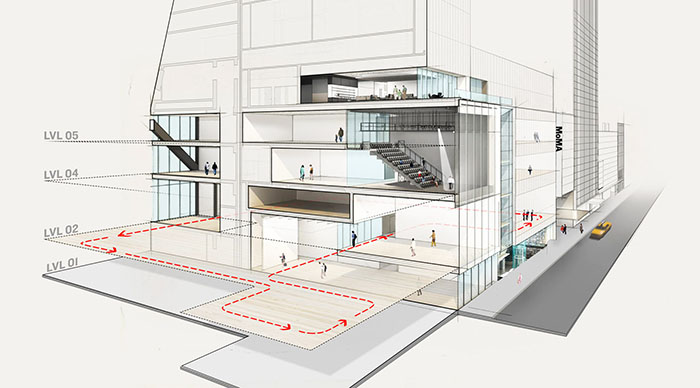MoMA 10/21 재개관: 양혜규 개인전 등 개막
The Expanded and Reimagined Museum of Modern Art to Open on October 21, 2019

The Museum of Modern Art announced on February 5, 2019, that MoMA will open its expanded campus on October 21, 2019, with a reimagined presentation of modern and contemporary art.
The expansion, developed by MoMA with architects Diller Scofidio + Renfro, in collaboration with Gensler, adds more than 40,000 square feet of gallery spaces and enables the Museum to exhibit significantly more art in new and interdisciplinary ways. The Studio in the heart of the Museum will feature live programming and performances that react to, question, and challenge histories of modern art and the current cultural moment. An innovative second-floor Creativity Lab for education will invite visitors to connect with art that explores new ideas about the present, past, and future. Street-level galleries, free and open to all on the expanded ground floor, will better connect the Museum to New York City and bring art closer to people on the streets of midtown Manhattan.

# Haegue Yang Handles
October 21, 2019–Spring 2020
Haegue Yang (Korean, b. 1971) is known for genre-defying, multimedia installations that interweave a range of materials and methods, historical references, and sensory experiences. Handles, Yang’s installation commissioned for MoMA’s Marron Atrium, features six sculptures activated daily, dazzling geometries, and the play of light and sound, to create a ritualized, complex environment with both personal and political resonance.
Handles are points of attachment and material catalysts for movement and change. Yang’s installation considers this everyday interface between people and things. Steel grab bars are mounted on the walls amid an iridescent pattern, and put to functional use in her sculptures. These monumental works come in distinctive shapes: some are inspired by the work of early 20th-century figures such as artist Sophie Taeuber-Arp and mystic philosopher G. I. Gurdjieff, and others use open-source designs for door handles to produce freestanding bodies at once futuristic and prehistoric. Mounted on casters and covered in skins of bells, the sculptures generate a subtle rattling sound when maneuvered by performers, and recall the use of bells in shamanistic rites, among other sources. The natural ambient noise of birdsong, which also permeates the space, was in fact recorded at a tense political moment in the demilitarized zone between North and South Korea during the historic summit in 2018. Reporters strained to hear the private conversation between the two nations’ leaders, but their audio devices only picked up the chirping of birds and the faint click of cameras.
Handles draws on Yang’s in-depth research into various sources, ranging from vernacular craft traditions to the historical avant-garde, esoteric spiritual philosophies to contemporary political events. She integrates these seemingly disparate narratives into an artistic language uniquely her own, offering a fresh take on modernism and a critical
reading of its legacy.
# member Pope.L, 1978–2001
October 21, 2019–February 1, 2020
Referring to himself as “a fisherman of social absurdity,” Pope.L has developed a body of work that poses provocative questions about a culture consumed with success yet riven by social, racial, and economic conflict. Resisting easy categorization, his career encompasses theatrical performances, street actions, language, painting, video, drawing, installation, and sculpture. Pope.L’s work explores the fraught connection between prosperity and what he calls “have-not-ness.” This tension is heightened by the presentation of these subversive artworks within a major art museum.
member: Pope.L, 1978–2001 focuses on a group of landmark performances that have defined the artist as a consummate agitator and humorist who has used his body to examine division and inequality on the streets and stages of New York City and in the more rustic environs of Maine, where he taught for 20 years.
The title member ponders the terms and stakes of membership for a provocateur who constantly strives “to reinvent what’s beneath us, to remind us where we all come from,” making material out of categories of race, gender, and citizenship that are intimately entwined.
# Betye Saar The Legends of Black Girl’s Window
October 21, 2019–January 4, 2020
After nearly a decade of focused work in printmaking, artist Betye Saar created her autobiographical assemblage Black Girl’s Window in 1969. This exhibition explores the relation between her experimental print practice and the new artistic language debuted in that famous work, tracing themes of family, history, and mysticism, which have been at the core of Saar’s work from its earliest days. Celebrating the recent acquisition of 42 rare, early works on paper, this is the first dedicated examination of Saar’s work as printmaker.
# Sur moderno: Journeys of Abstraction The Patricia Phelps de Cisneros Gift
October 21, 2019–March 14, 2020
Sur moderno: Journeys of Abstraction—The Patricia Phelps de Cisneros Gift is drawn primarily from the paintings, sculptures, and works on paper donated to the Museum by the Colección Patricia Phelps de Cisneros. This extraordinarily comprehensive collection provides the foundation for a journey through the history of abstract and concrete art from South America at mid-century. The exhibition explores the transformative power of abstraction in Brazil, Venezuela, Argentina, and Uruguay, focusing on both the way that artists reinvented the art object itself and the role of art in the renewal of the social environment.

# Surrounds 11 Installations
October 21, 2019–January 4, 2020
How do artists mediate between the need for intimate experience and the ambition to engage with the enormity of the world? Surrounds presents 11 watershed installations by living artists from the past two decades, conceived out of different circumstances but united in the scale of their ambition. Each explores physical scale as well: many are large and imposing, at times even literally surrounding the viewer. Others group smaller works into sequences that stretch across space. Some suggest the passing of long stretches of time, and some focus our attention on the stuff of everyday life. All mark decisive shifts in the careers of their makers and are on view at MoMA for the first time.
Surrounds includes work by Jennifer Allora and Guillermo Calzadilla, Sadie Benning, Janet Cardiff and George Bures Miller, Sou Fujimoto, Sheila Hicks, Arthur Jafa, Mark Manders, Rivane Neuenschwander, Dayanita Singh, Hito Steyerl, and Sarah Sze.
# Private Lives Public Spaces
October 21, 2019–July 5, 2020
Long before camera phones, the 1923 introduction of small-gauge film stock heralded the unofficial birth of affordable home moviemaking. Over the subsequent decades, many thousands of reels of amateur film shot around the world amounted to one of the largest and most significant bodies of moving-image work produced in the 20th century.
Artists, celebrities, world travelers, and the public at large, using 16- and 8-millimeter equipment, employed this unregulated, democratic form of personal filmmaking to produce work that is by turns vigorous, sentimental, frank, and sometimes transgressive. Sadly, these films were also rarely preserved and commonly abandoned, often ending up as flea market curios or stock footage as more consumer-friendly video formats arrived in the 1980s. Private Lives Public Spaces, the Museum’s first gallery installation of home movies and amateur films drawn exclusively from its collection, shines a light on a seldom-recognized cinematic revolution.
This 100-screen presentation of virtually unseen, homemade works dating from 1907 to 1991 explores the connections between artist’s cinema, amateur movies, and family filmmaking as alternatives to commercial film production. Staged as an immersive video experience, the exhibition reveals an overlooked history of film from the Museum’s archives, providing fresh perspectives on a remarkably rich precursor to the social media of today.
# Energy
October 21, 2019–January 26, 2020
Energy is the indispensable fuel of life for all species. For humans, it has become almost an addiction. The search for new sources of energy and the exploitation of existing ones have driven progress, formed and informed cultures, transfigured landscapes, and ignited wars. Throughout the 20th century, everything from objects to buildings and entire cities was conceived to maximize immediate output and productivity. Modern architecture and design were powered by electricity, and linked to energy production and distribution. In order to secure energy, we have deforested, drilled, mined, extracted, removed mountaintops, and terraformed the planet.
In the 21st century, many designers have become aware of their role and responsibility in these disruptive activities, and have adjusted their practices accordingly. If in the past design led us to devour energy at an ever-growing rate, design can now help us conserve it and behave more responsibly. The objects presented here engage with energy in its myriad forms—from thermal and kinetic to electrical and even reproductive. They represent its sourcing, deployment, consumption, and preservation. They showcase the technological advancements of the past decades, while proposing alternatives for a future in which resources might not be as readily available.
# Taking a Thread for a Walk
October 21, 2019–Spring 2020
Anni Albers wrote in 1965, “Just as it is possible to go from any place to any other, so also, starting from a defined and specialized field, can one arrive at a realization of ever-extending relationships . . . traced back to the event of a thread.”
Such events quietly brought about some of modern art’s most intimate and communal breakthroughs, challenging the widespread marginalization of weaving as “women’s work.” In Albers’s lifetime, textiles became newly visible as a creative discipline—one closely interwoven with the practices of architecture, industrial design, drawing, and sculpture. A key driver for the development of new languages for woven forms was the emergence of interdisciplinary educational institutions such as the Bauhaus school of art and design, Cranbrook Academy of Art, and Black Mountain College. These schools championed experiential learning—or learning through doing—an approach that had been in part inspired by progressive early-childhood teaching models of the 19th century.
True to its title, this exhibition takes a thread for a walk among ancient textile traditions, early-20th-century design reform movements, and industrial materials and production methods. Featuring adventurous combinations of natural and synthetic fibers and spatially dynamic pieces that mark the emergence of more a sculptural approach to textile art beginning in the 1960s, this show highlights the fluid expressivity of the medium.








